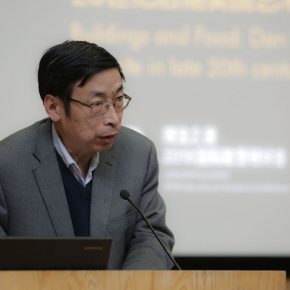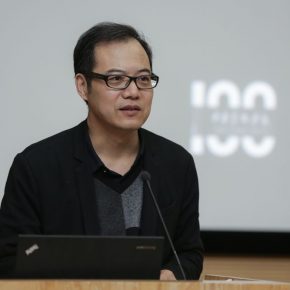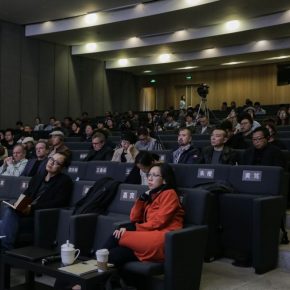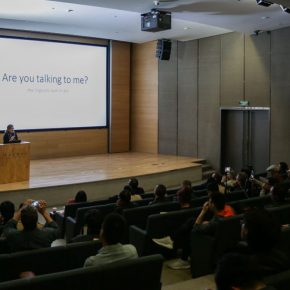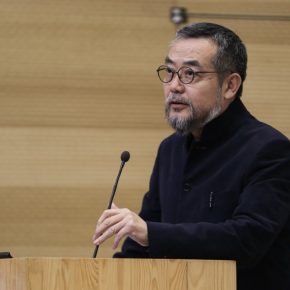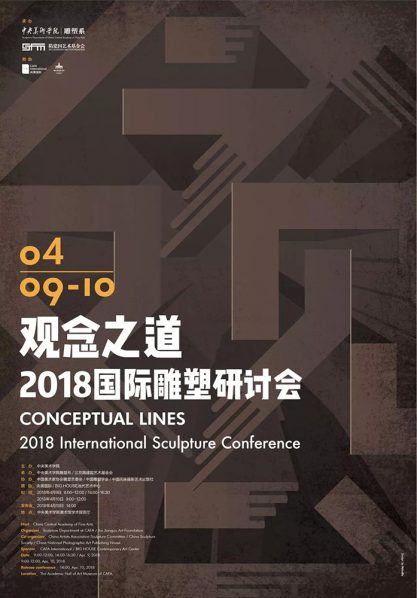
“Conceptual Lines: 2018 International Sculpture Conference”, co-organized by the Sui Jianguo Art Foundation and the Department of Sculpture, Central Academy of Fine Arts (CAFA) took place at CAFA on April 9 and 10, 2018. More than twenty local and international scholars and professionals gathered with speeches starting from “conceptual art” to respectively delivered in three sections including “History and Theory”, “Context and Scene”, and “Inheritance and Expansion”, to discuss international contemporary art forms and the profound influences of “conceptual art” on Chinese contemporary art, especially the influences on sculpture. Prof. Lyu Pinchang, Director of the Department of Sculpture, Central Academy of Fine Arts, hosted the opening ceremony, and Su Xinping, Vice President of Central Academy of Fine Arts, attended the opening ceremony and delivered a speech.
In the 1960s, there was an obvious tendency that the artists’ pure, anti-intellectual and intuitive ways of artistic creation over the past two decades was gradually being replaced by conceptualized art that emphasized thinking, ideas and concepts. Sheng Wei, Secretary General of the Curator Committee of China Artists Association and Academic Coordinator of the conference, said that this conference aimed at discussing “conceptual art in a narrow sense”, and conceptual art was of neo-avant-garde features, such as self-criticism, anti-art and anti-system, etc., with language as the main method to reveal a strong philosophical tendency, and it was closely associated with Western social conditions, capitalism and media advancement at the same time. It could be traced back to Dadaism and early Realism, and it could be extended to contemporary art.
In the first section themed “History and Theory”, Zhang Xiaojian, Deputy Dean of the School of Art and Design, Wenzhou University, Zhu Cheng, Assistant Researcher of the CAFA Institute of Art and Design, Chen Anying, Director of the Department of Art History of the Academy of Arts & Design, Tsinghua University, Wang Chunchen, Deputy Director of CAFA Art Museum, Prof. Yin Shuangxi, Editor-in-Chief of Art Studies, Central Academy of Fine Arts, and Chang Peijie, Lecturer of the Department of Literary Theory of the School of Literature, Renmin University of China, Wang Zhiliang, Associate Professor of the School of Arts, Hebei University, and Wu Yiqiang from the Institute of Aesthetics and Literary Criticism, Zhejiang University, respectively delivered a keynote speech.
The complexity and confusion of the theories of conceptual art and a series of related aesthetic issues were discussed in this section. For the emergence of the idea of conceptual art, the definition of “art” was more blurred and controversial – “For the two identical items, how do we separate an artwork from a common item?” “The Transfiguration of the Commonplace” describes a story of when Arthur C. Danto planned an imaginary exhibition entitled “Red Squares Exhibition”. Each work contained nine red square canvases of the same size: “Kierkegaard’s Emotion”, a portrait created by the sensitive Danish artist; the still-life painting of “Red Tablecloth” created by Matisse’s student, the religious work of “Nirvana”, two works that were both entitled “Red Square”, including a landscape of Moscow and a geometric abstract painting, and these six paintings were indisputably classified as “artworks”; the 7th painting was a red canvas that came from the Venetian painter Giorgione’s workshop, which could only be regarded as a “historic item”; the eighth painting that used red leads to the drawing of the ground color of the canvas which was “commonplace”; the ninth painting was created by an angry young artist “J. Seething”, who also shared his own painting of red squares entitled “Untitled” – it was reluctantly considered as an artwork by Danto, who also declared that it was “not rich in theme” and was “empty” at the same time. Danto said that it was an artwork because it was associated with the art world at that time.
“History and Theory” focused on the interpretation of the definition of conceptual art, the philosophical origins, cultural trends and the relationships with the social movements and changes. For example, Dr. Zhang Xiaojian started from “Minimalism” to discuss its influence on conceptual art and the transformation. Dr. Chang Peijie said that modern art was deeply influenced by the all-round development of the nominal since the Middle Ages, and he used aesthetic nominalism to discuss the emergence of conceptual art; Lucy Lippard’s “Six Years: The dematerialization of the art object from 1966 to 1972” was focused on by many scholars. Prof. Chen Anying discussed the “non-material concept” in conceptual art. Prof. Wang Chunchen delivered a keynote speech on “Non-material Concept in Sculpture”, and Dr. Zhu Cheng also started from this book to discuss the transformation of logic in conceptual art.
“Context and Scene” invited many foreign scholars, and scholars who had studied the history and theory of Western art, including Canadian curator Yan Wu, who serves as the public art consultant of Markham, Canada, James Carl, Professor of University of Guelph and a sculptor, Prof. Jon Isherwood, Head of the Department of Sculpture, Benington College, USA, Dr. Zhang Wei, Research Fellow, Institute of Contemporary Art and Social Thoughts, China Academy of Art, Prof. Peggy Gale, an independent curator from Canada, Dr. Shao Yiyang, Deputy Dean of the School of Humanities, Central Academy of Fine Arts, Oliver Kaeppelin, a curator from France, Dr. Zhou Wenji, Lecturer, Department of Film and Television Art, Shanghai College of Film, Shanghai University, and Dr. Liu Libin, Associate Research Fellow, Institute of Fine Arts, Central Academy of Fine Arts.
The speakers of this part mainly used representative conceptual artists as examples to conduct analysis. Prof. James Carl introduced the influence of Dan Graham and Gordon Matta-Clark on American art in the late 20th century, especially the art that involved in the public art, social cooperation and popular culture; Jon Isherwood talked about the rock music as described in Dan Graham’s “Rock My Religion”, and he shared some music clips with the audience; Prof. Peggy Gale shared her two books – “Artist Lecture: 1969-1977” (2004), and the earlier “Art Museum of the Artists” (1983), and she said that these two books had created an intellectual history of art practice of the artists, institutions, publishers and teachers; Prof. Shao Yiyang took Anish Kapoor as an example and introduced his classic artworks created in the transition period between minimalist sculpture and conceptual art; Prof. Olivier Kaeppelin shared with the audience the practice and design of Eva Hesse, who was closely associated with minimalist artists.
In the “Inheritance and Expansion”, the speakers extended the “conceptual art” discussed in the above two sections. Prof. Elizabeth Presa, Director, University of Melbourne and the Victoria College of Arts Creative Arts Center, Australia, Barbara Fischer, Director and the chief curator of the University of Toronto Art Centre, Dr. Huang Du, an independent curator, Carol Yinghua Lu, Director of Inside-Out Art Museum, Dr. Pi Li, Senior Curator at M+, Prof. Zhan Wang from the Department of Sculpture, Central Academy of Fine Arts, Dr. Su Lei, Lecturer at the School of Earth and Space Science of Peking University, respectively delivered a speech.
Prof. Barbara Fischer took Canadian art as an example to discuss the changes of philosophical “discourses” in the history of conceptual art and analyzed the lasting influence of this part of history on the art since the 1960s. Dr. Huang Du introduced Japanese “Mono-ha” that emerged in the late 1960s and elaborated the expression of conceptual art from an oriental perspective; the curator Pi Li introduced how the Chinese artist Zhang Peili did get into the practice of conceptual art “with a realistic tail”; Prof. Zhan Wang talked about his article published in “Art Studies” 20 years ago, and discussed the idea of “conceptual sculpture” again.
“Conceptual Lines – 2018 International Sculpture Conference” is different from the traditional sculptural workshop. Rather than defining it with a material concept and the sculptural concept in the narrow sense, it has been extended to the “conceptual art”.
It also launched two books: Lucy Lippard’s “Six Years: The dematerialization of the art object from 1966 to 1972”, and Dan Graham’s “Rock My Religion” at the same time, and a book launch was presented on the afternoon of April 10.
Text by Lin Jiabin, translated by Chen Peihua and edited by Sue/CAFA ART INFO
Photo by Hu Sichen/CAFA ART INFO







